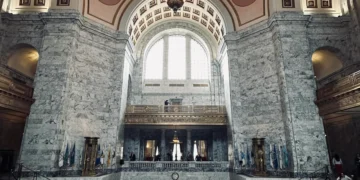Dec 8, 2024 Story by: Editor
ST. LOUIS — The St. Louis Reparations Commission has unveiled a report addressing decades of racial injustice against Black residents, suggesting measures like public apologies and financial compensation.
The commission, established by Mayor Tishaura Jones in late 2022, conducted nearly 30 listening sessions over 18 months to document the extensive harm faced by African Americans in the city.
“We knew that we had to address some really deep, deep core issues in the community around trust, around transparency, around racial healing, and restorative justice,” explained Will Ross, the commission’s vice chair.
Ross emphasized that systemic discrimination was intentional and deeply entrenched. “Too many times we blame the person for the predicament they’re in. We want to say these are these external forces, these really powerful external forces that really constrain the health of Blacks in St. Louis,” he added.
Recommendations for Reparations
The report’s recommendations, divided into restitution- and policy-oriented categories, have been forwarded to the city’s Board of Aldermen. Suggestions include adopting a formal historical record acknowledging racial harms, direct cash payments for individuals impacted by systemic racism, and targeted payments to descendants of residents from historically harmed areas like Mill Creek Valley.
Ross noted that the commission’s work ensures city officials have ample documentation and community input to make decisions. “They spoke, and we heard them,” he stated.
According to deputy communications director Rasmus S. Jorgensen, the mayor’s office is evaluating which recommendations can be implemented. Some initiatives, like affordable housing, public Wi-Fi, and neighborhood revitalization, are already underway. However, Jorgensen warned that direct cash payments could strain the city’s resources, citing legal challenges faced by similar programs, such as Evanston, Illinois’ reparations program.
Historical and Community Context
The report, which acknowledges St. Louis as ancestral land for Native American nations, is organized into themes including housing, education, public health, economic justice, criminal justice reform, and cultural preservation.
One prominent narrative is the displacement of Mill Creek Valley residents during the 1960s under discriminatory urban renewal policies. Vivian Gibson, who was displaced as a child, shared her memories of leaving her family home. “I just really wanted to talk about my family’s experience and how it impacted the future of my parents, siblings, and me,” she said.
Gibson stressed the importance of reparations, saying, “We could never be whole if we don’t bring everyone along.”
Growing Momentum for Reparations
Nationally, the movement for reparations is gaining traction. Justin Hansford, Law professor at Howard University and executive director of the Thurgood Marshall Civil Rights Center, highlighted that around 30 cities and states have formed commissions to explore reparations. This number could grow to 100 within a few years.
Hansford, who is also a member of the United Nations’ Permanent Forum on People of African Descent, emphasized that reparations extend beyond cash payments. “We’re thinking about policies, the changing of laws, creating financial investments into health care, housing, and education to try to bridge those disparities,” he explained.
He urged communities to craft reparations tailored to their unique histories and experiences. “Each community needs to tell its story, in its own voice, in its own words, with its own particular angle,” he said.
The St. Louis report reflects an earnest effort to confront the city’s history and seek justice for its Black residents. Whether or not its recommendations are fully adopted, it has set a precedent for addressing systemic racial inequalities. Source: PBS

















